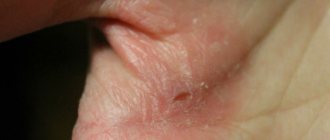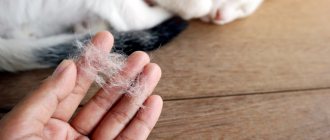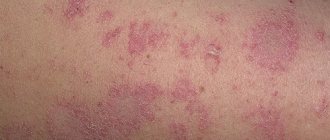Symptoms and treatment of feline eczema
Regardless of the reasons for the appearance of inflammation in the upper layer of the epidermis, the signs of the disease are the same.
- The very first symptom is redness. This occurs as a result of the fact that it is in this area of the dermis that there is lymph and blood circulation.
- Itching. The place where the inflammation began is itchy, and the cat persistently tries to scratch it. Toxins accumulate in tissues, nerve endings are irritated - this is why itching occurs.
- If you touch a red area of skin, you can record an increased temperature in this spot. Sensitivity also increases.
- As a result of intoxication, bubbles appear. In the dry form, the blisters burst and the skin peels off; usually this form is characteristic of a chronic course. In the wet form, liquid leaks from the ruptured blisters, and the wound is constantly wet. This occurs due to infection of the inflamed area. Scratched wounds receive pyogenic microflora, which provokes wet, festering wounds.
Treatment
The diagnosis must be made by a specialist and treatment prescribed.
Primary measures:
- Isolate the cat from drafts and cold places.
- Treat against fleas, worms and free her from the collar (if she is wearing) during treatment.
- If eczema is a secondary disease against the background of inflammation of internal organs (this is also determined by a veterinarian), the underlying disease must be treated.
- Analyze your pet’s diet, eliminate potential allergens, and introduce vitamins.
- It is better to shave the affected area, this will avoid infection, and also treat it with alcohol or Chlorhexidine.
Treatment with drugs:
- To reduce a cat's irritability, bromine is recommended.
- To normalize skin sensitivity, sodium thiosulfate is needed.
- Antihistamines: Suprastin, Diphenhydramine.
- Methylprednisolone, Prednisolone and Dexamethasone are effective in treating eczema.
- Furosemide is needed as a diuretic to rid the body of toxins.
- Weeping eczema in cats requires treatment with Chlorhexidine, peroxide or Miramistin.
- To provide an astringent effect, a solution of tannin or silver nitrate is required.
- Zinc ointment is suitable for drying pappules.
- If a cat has dry eczema, Vishnevsky ointment helps.
Folk remedies are also appropriate in the treatment of eczema.
- Treatment of the affected area with chamomile decoction, calendula solution, oak decoction (has an astringent effect) is effective.
- St. John's wort oil removes dry eczema and accelerates cell regeneration.
- Aloe juice has a wound healing effect.
Disease prognosis
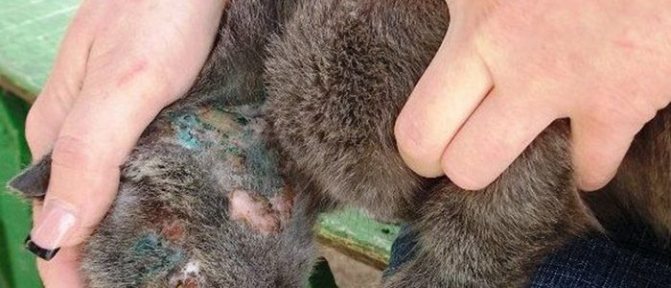
Eczema can occur in acute and chronic forms. Acute is typical for young cats, chronic - for cats over 6 years old, as well as for weakened pets.
The acute form can last about a month, and intensive treatment is effective in combating it.
Etiology
The cause of eczema can be damage of a mechanical nature (combing, scratching, gnawing, cracks), thermal (exposure to high temperatures and direct sunlight), chemical (medicines, preparations for the care of animal skin, medications).
Infectious diseases are accompanied by eczema as a clinical sign (erysipelas, plague, smallpox) and also cause the manifestation of pathology.
The cause of eczema can also be a disruption of the functioning of internal organs, intoxication, allergens, and endocrine glands.
Eczema can manifest as a uniform rash (papular eczema) or a polymorphic form (pustules, papules).
The process can be limited, local, or generalized. Pathology also has acute, subacute or chronic forms. If acute processes, as a rule, are wet, then, turning into chronic ones, they become dry.
For eczema of a non-infectious nature, seasonality is clearly expressed. The pattern is especially noticeable in long-haired animals.
Reasons: why does the disease develop?
External and internal factors are involved in the development of disease symptoms in cats.
External factors often include:
- Wool dirt;
- Constant friction;
- The influence of parasites;
- Using soap when bathing an animal;
- High or low temperatures;
- Microbial infection.
Internal factors that can cause weeping eczema in cats include:
- Weak immunity;
- Endocrine pathology;
- Ovarian dysfunction;
- Diseases of internal organs.
Traumatic
Dry and weeping eczema in a cat can be triggered by a variety of injuries, insect bites, and mechanical irritation of the skin. In addition, the following factors may be to blame for the disease:
- unhealthy and unbalanced diet;
- lack of vitamins and microelements in the body;
- hormonal imbalance.
Veterinary specialists distinguish several reasons leading to the development of the disease in domestic cats. They are usually classified into groups according to the type of disease they cause.
Reflex

The causes of this group affect the skin both externally and internally. Of the external factors, mechanical, thermal, chemical and microbial influences most often lead to the development of eczema. Mechanical causes - friction, scratching for skin diseases, exposure to external parasites.
Thermal factors include exposure to cold, hot air, burns and frostbite on the skin. This group also includes exposure to ionizing radiation on animals.
The causes of skin diseases of a chemical nature include irritating acids, alkalis, chemicals, aggressive detergents, medications in the form of ointments, purulent discharge during inflammatory processes.
Exposure to skin microorganisms can be both a direct and indirect cause of the development of eczema.
Experts include diseases of animal organs as internal irritants: thyroid, liver, ovaries, kidneys, intestines. The products of inflammatory reactions, spreading through the bloodstream, have an irritating and sensitizing effect on skin cells.
Often the cause of the reflex form of the disease is an allergic reaction of the body to a particular allergen.
Causes of eczema
Like many other skin diseases, eczema occurs against the background of a weakened body. Among the factors causing this disease:
- Excessively dry or, conversely, damp skin;
- hormonal disorders;
- poor nutrition;
- allergies;
- pathologies of immunity;
- emotional stress and stress;
- diseases of the gastrointestinal tract, liver, kidneys, nervous system;
- insufficient or excessive care.
Similar reasons are typical for many people, therefore
Treating eczema in cats at home
Therapy should be started based on the cause that provoked the pathology, the stage of the disease and the general condition of the pet.
- The first step is to eliminate the cause.
- In parallel, general therapy and local treatment are carried out.
- Sedatives are used, including bromine and caffeine.
- Sensitization requires the use of nonspecific desensitizing treatment: the prescription of sulfonamide drugs, the use of antibiotics. But they also use novocaine blockade and carry out restorative treatment.
- Vitamins are recommended to maintain body tone.
- Elimination of intoxication is carried out through the use of diuretics - furosemide, methenamine.
Diuretic drug Hexamine is used as a diuretic.
You should try to carefully remove the crusts using hydrogen peroxide and tweezers
Treatment of weeping eczema requires the use of antiseptics, which act as astringents that promote compaction and limit the release of exudate.
- The means used are a ten percent solution of tinin or formaldehyde.
Formalin solution is used as an antiseptic.
Mercury-zinc ointment is used already at the healing stage.
Eczema in cats is an inflammatory skin disease caused by hypersensitivity of the skin. Eczema is an unpleasant disease that is difficult to treat. Usually the disease torments the animal for the rest of its life, despite the efforts of the veterinarian and the owner.
{amp}gt;Causes and types of eczema
Diagnostics
To identify the disease, you should contact your veterinarian. Although even the owner himself can easily determine that his beloved cat has eczema by the appearance of his skin. Red spots, loose fur, the presence of discharge - these signs can be used to diagnose the disease.
Before visiting the veterinarian, it is recommended not to smear the affected surface with anything. The veterinarian conducts a survey of the pet owner to identify the causative factors in the cat's eczema.
Then they proceed directly to examining the damaged surface of the skin. Eczema in cats is marked by erythematous areas, blisters with clear contents, ulcers with wet areas, and crusts.
The pet exhibits restless behavior. Additional examination: general blood test, urine test.
Before visiting the veterinarian, it is recommended not to smear the affected surface with anything. The veterinarian conducts a survey of the pet owner to identify the causative factors in the cat's eczema.
Then they proceed directly to examining the damaged surface of the skin. Eczema in cats is marked by erythematous areas, blisters with clear contents, ulcers with wet areas, and crusts.
The pet exhibits restless behavior. Additional examination: general blood test, urine test.
Before visiting the veterinarian, it is recommended not to smear the affected surface with anything. The veterinarian conducts a survey of the pet owner to identify the causative factors in the cat's eczema.
Then they proceed directly to examining the damaged surface of the skin. Eczema in cats is marked by erythematous areas, blisters with clear contents, ulcers with wet areas, and crusts.
The pet exhibits restless behavior. Additional examination: general blood test, urine test.
Diagnostic measures
If an owner suspects wet eczema in a pet, it is important to visit a veterinary clinic with the kitten as soon as possible. At the appointment, the doctor will conduct a survey and find out how long ago the cat’s weeping wound was noticed. Mostly, a primary examination is enough for a doctor to make a diagnosis. However, it is also necessary to identify the factor that caused the disease.
For these purposes, the animal is first sent for skin scrapings, which make it possible to identify the possible presence of other dermatological diseases. For example, psoriasis is often diagnosed in cats. If the veterinarian suspects an infectious lesion of the epidermis, a bacteriological culture is performed.
How does eczema develop?
Before treating eczema in a cat, you should familiarize yourself with the mechanism of development of this disease.
The first stage begins with redness of the skin, this occurs due to poor circulation or stagnation of lymph. Further, the accumulation of poisons and decay products occurs in the skin. They attack tissue and cause severe itching in cats.
Then, bubbles appear on the surface of the cat’s epidermis and become covered with scales. This is what dry eczema looks like.
READ MORE: Red moles on the body reasons for their appearance in women: what the body signals about
When the form becomes weeping, the papules burst and the serous contents spill onto the surface of the skin. Then infection occurs. When the pathological process subsides, the blisters become covered with crusts.
Frequent itching leads to the cat feeling severe discomfort, her health worsens, and sometimes her body weight decreases. If a cat has eczema, the immune system weakens and the body's resistance to infections decreases. This disease develops similarly in dogs.
Mechanism of development of eczema
Since the skin is connected to the internal organs, their condition is also interdependent.
Eczematous skin lesions most often appear against the background of metabolic disorders. Disturbed processes of heat exchange, sweating and vascular reactions increase skin sensitivity when exposed to various types of allergens. This leads to the development of various types of eczema in the animal.
Toxic metabolic products entering the blood (due to disruption of the gastrointestinal tract or excretory system) cannot be completely neutralized in the liver, but are partially excreted through the skin. This also leads to the appearance of secondary foci of inflammation. In its development, eczematous lesions go through several stages:
- At the erythema stage, itchy redness appears on the surface of the skin, which spreads when scratched and can cause infectious complications.
- The papular stage replaces the erythematous stage and is characterized by the appearance of compactions, or so-called nodules (papules), rising above the surface of the skin in the affected areas.
- The vesicular stage occurs when papules turn into vesicles - vesicles filled with serous contents.
- In the future, if the disease takes the path of developing dry eczema, the blisters gradually resolve. In their place, a dry, flaky and flaky surface appears.
- If wet eczema develops, the contents of the vesicles are replaced by a leukocyte infiltrate. The vesicles are replaced by pustules (ulcers). When they open, they form a continuous ulcerated surface with pus. This form of the disease is the most dangerous and fraught with complications.
The initial stage of eczema is characterized by redness of the skin and severe itching. Usually, to identify the disease, it is enough to touch the “suspicious” area: with eczema, its temperature increases noticeably.
At the beginning of the disease, hair falls out on the affected area, and the skin becomes hot.
A cat with eczema is restless and constantly itches, causing bacteria to enter the inner layers of the epidermis. Over time, the animal's skin becomes covered with small nodules and compactions (papules), which, in turn, turn into blisters (vesicles) filled with a grayish liquid.
There are two options for the further development of the disease:
- With wet eczema, the vesicles burst and their contents leak out. Pyogenic bacteria occupy the affected areas, causing the formation of ulcers, erosions and pustules. The skin becomes inflamed, swollen, and becomes damp to the touch. Attempts to touch the affected areas cause severe pain in the cat.
- With dry eczema, the vesicles dissolve and dry out. The crusts formed at the site of the bubbles fall off, which creates the effect of constantly flaking skin.
Before starting treatment for a sick cat, the owner should inquire about the mechanism of development of the disease. Experts believe that for some reason there is a violation of blood and lymph circulation in an area of the skin. At this stage, redness of the skin is observed.
In the tissues of the dermis, concentrations of poisons, toxins, and waste products accumulate. These phenomena lead to intoxication of the upper layers of the epidermis and cell hypoxia. The affected skin becomes hypersensitive to external or internal irritants. Sensitization occurs. Due to irritation of the nerve endings, the animal experiences itching. The processes of intoxication and sensitization trigger the formation of bubbles on the pet’s skin.
Papules rise above the surface of the skin and are covered with scales. This is how the dry form of eczema develops.
With the weeping form of the disease, serous exudate begins to form in the superficial layers of the skin. In place of the papules, vesicles form. When they are opened, the contents are released onto the surface of the skin. This forms a pustule with purulent contents. The wet stage is accompanied by erosion. When the pathological process subsides, crusts form in place of the pustules.
The scaly stage is characterized by the formation of horny plates in the upper layers of the epidermis in the form of a pityriasis-like plaque. This phase of the pathological process is characterized by recovery of the skin and hair.
Changes in the microstructure of the upper layers of the epidermis weaken the barrier and protective function of the skin and negatively affect the mental and general health of the pet.
Symptoms
The initial stage of development of the disease is manifested by the following symptoms:
- redness of the dermis;
- itching: the animal constantly scratches and tries to bite a separate area of the body;
- feeling of heat in the affected areas;
- irritability and aggressive behavior of the pet;
- seals like bubbles on the skin, inside of which gray liquid accumulates over time.
The further course of the pathological process depends on the nature of the disease. There are two types of it.
https://www.youtube.com/watch?v=5fr4vPy7hXQ
Veterinarians distinguish three main forms of the disease.
The disease occurs in three forms - acute, subacute and chronic. Weeping eczema can occur in any course, although the chronic form most often occurs in the form of flaky crusts.
Acute form
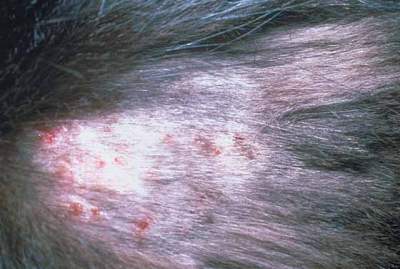
The acute form is characterized by a variety of rashes.
Signs of the disease must be divided according to the type of eczema in cats - wet or dry. At the beginning, similar clinical manifestations appear in both forms of the disease.
The inflammatory process is distinguished by the following stages of development:
- Erythematous.
- Papular.
- Vesicular.
Erythematous stage
Because of the fur, the owner does not always immediately detect signs of eczematous pathology in a dog or cat. With regular examination, lesions can be detected promptly.
Because of the fur, the owner does not always immediately detect signs of eczematous pathology in a dog or cat. With regular examination, lesions can be detected promptly.
Regardless of the reasons for the appearance of inflammation in the upper layer of the epidermis, the signs of the disease are the same.
Methods of treating the disease
When the first symptoms of eczema appear, you should contact the clinic. The main thing is not to treat your pet’s skin before visiting the veterinarian: antiseptic agents can relieve inflammation and complicate diagnosis. Usually eczema is determined visually, but if necessary, a specialist can scrape the affected area.
At the first sign of eczema, your cat should be taken to a veterinarian.
When it comes to treating eczema in cats, topical medications are usually used. Unlike injections and tablets, they are simple and easy to use. To facilitate access to the affected skin, the hair at the site of the appearance of papules and vesicles is cut off.
As a rule, the disease is treated with:
- astringent or moisturizing ointments (for wet and dry eczema, respectively);
- local hormonal medications to speed up the skin healing process;
- antiseptics designed to destroy pathogenic microorganisms;
- sedatives;
- immunostimulating agents to increase the body's defenses (Fosprenil, Ribotan, etc.);
- broad-spectrum antibiotics (Amoxicillin, etc.);
- special vitamin complexes.
Important. Long-term use of the same drugs can cause addiction. To prevent this from happening, medications must be alternated. The choice of medications for the treatment of eczema should be discussed with your veterinarian.
Characteristic features of the disease in pets
As a rule, eczema in animals is in many ways similar to the pathology that occurs in humans. Veterinarians also often confirm the weeping and dry forms of the disease, the acute and chronic stages. By the way, the latter is not characterized by exudative-erosive weeping; the disease is accompanied by dry skin, peeling and the appearance of cracks.
Based on the nature of origin, the following types of dermatosis in animals are distinguished:
- neuropathic;
- near-wound;
- reflex;
- paratraumatic.
The causes of this skin disease are not exactly clear to doctors, however, the situation is similar to the human disease. But unlike us, four-legged animals suffer more from eczema. If a patient with dermatosis experiences the greatest discomfort during an exacerbation, then the animal’s body is subjected to torment during remission. Often, pets with eczema lose significant weight, become weak, and have an almost constant fever.
Recognizing eczema in animals on your own is not easy. In the vast majority of cases, especially when it comes to cattle diseases, the owners detect the disease in the later stages. One of the sure signs of dermatosis in an animal will be its attempts to gnaw and bite itself, caused by itching, pain, and burning.
If you make a kind of ranking based on the frequency of the disease, then dogs will be the leaders, horses will be in second place, then cats, cows and other representatives of cattle. However, the signs of the disease in representatives of different species are not fundamentally different. Eczema in animals usually goes through several stages of development.
Prevention measures
Prevention of eczema in cats is a set of measures that reduce the risk of triggering factors. It includes several areas:
- skin hygiene;
- fight against skin parasites and timely deworming;
- balanced nutritious nutrition;
- prevention of allergic reactions;
- timely replacement of collars, harnesses and other accessories that do not fit the animal in size and that rub the skin;
- prevention of severe stress;
- It is important to avoid severe overheating or hypothermia of the body.
After the main symptoms have been relieved and the treatment of the animal has been completed, monitoring of the health condition cannot be weakened. Otherwise, the disease may recur. If you have the slightest signs, you should immediately consult a doctor.
Great importance is attached to general and differential diagnosis, which is impossible to carry out at home. Only a correct diagnosis and competent therapy provide confidence that the disease will be defeated.
In order not to provoke the occurrence of eczema in a cat, it is important for the owner to systematically carry out deworming and treatment against ectoparasites. You need to constantly inspect your pet’s skin and change collars on time. Diet is important. The menu should not contain food that can trigger allergic reactions. It is important to monitor your pet’s hygiene and carry out water treatments at least once every 2 months.
Ркзема (ekzema)
Ркзема (ekzema) – заболевание поверхностных слоев кожи, СЃРѕРї SЂРѕРІРѕР¶РґР°СЋС‰РµРµСЃСЏ полиморфизмом РІС ‹СЃС‹РїРµР№. Ркземой болеют РІСЃРµ SЃРµР»СЊСЃРєРѕС…озяйственные животныРµ, Р° также собаки Ро кошки .
RS‚иология.
Рљ экзогенным причинам относят механические (С‚СЂРµС ‰РеРЅС‹, расчесы), физические (дейст RІРеРµ высокой температуры Рё прямых солнечных лучеР№, Сѓ овец – после стрижки), With… имические (действие лекарственных веществ, СЃРѕРґРµС ЂР¶Р°РЅРёРµ животных РЅР° РіСЂСЏР·РЅРѕР№ подстилке) . Рндогенными причинами SЏРІР»СЏСЋС‚СЃСЏ заболевание внутренних органов (печени, легких, желудочно-РєРёС €РµС‡РЅРѕРіРѕ тракта), нарушение SЃРµРєСЂРµС†РёРё SЌРЅРґРѕРєСЂРёРЅРЅС‹С… же лез, кормовые РентоксикацРеРё, попадание РІ организм различных аллергенов.
Клинические признаки.
RџСЂРё S‚ипичном S‚ечении R±РѕР»РµР·РЅСЊ RїСЂРѕС…РѕРґРёС‚ SЃРµРјСЊ SЃС‚адий С ЂР°Р·РІРёС‚РёСЏ: эритоматозную – рез РєРѕРµ покраснение непигментированной кожи; папулезную – ограниченные RєРѕР¶РЅС‹Рµ RїР»РѕС‚ные РїРѕР·РІС‹С €РµРЅРёСЏ, РЅРµ исчезающие РїСЂРё надавливании пальцем; везикулярную – появление пузырьков (везикуД) СЃ серозным содержимым; пустулезную– появление мелких РіРЅРѕР№РЅРєРѕРІ (пустуД), Rѕ бразующихся РїСЂРё инфицировании везикул; мокнущую – самопроизвольное вскрытРеРµ пустул, изли СЏРЅРёРµ экссудата Рё склеРевание РёРј волос; РєРѕСЂРєРѕРІСѓСЋ – высыхание SЌРєСЃСЃСѓРґР°С‚Р° Рё образование SЂР°Р·Р»РёС ‡РЅРѕРіРѕ цвета РєРѕСЂРѕРє; чешуйчатую – отторжение высохшего СЂРѕРіРѕРІРѕРіРѕ СЃР»РѕС Џ, появление S‡РµС€СѓРµРє. Следует отметить, что строгая RїРѕСЃР»РµРґРѕРІР°С‚ельноS ЃС‚СЊ описанных выше стадий экзематозного процесса РЅРµ обязательна.
Местные измененнв Сэкзематозном SѓС‡Р°СЃС‚РєРµ, как правило, сопровождаются Р·СѓРґРѕРј.
РЈ РєСЂСѓРїРЅРѕРіРѕ рогатого скота Рё лошадей экзема РЅР°Реболее С ‡Р°СЃС‚Рѕ поражает кожу РІ области пальца, холки, СЃРїРёРЅС‹, живота, Сѓ Сѓ СЃРѕ±Р°Рє – РІ РѕР±Р»Р°СЃС ‚Рё СЃРїРеРЅС‹, хвоста, ушной раковвны головы.
ЛечеРСРеРµ. RќРµРѕР±С...РѕРґРёРјРѕ SѓСЃС‚ранить RїSЂРёС‡РёРЅСѓ R·R°R±РѕР»РµРІР°РЅРёСЏ.
РџСЂРё острых экземах РІ стадиоЏS… образованнвпузырьков, R їСѓСЃС‚СѓР”, мокнущей экземе применяют РІСЏР ¶СѓС‰РёРµ SЂР°СЃС‚РІРѕСЂС‹: 3–4 – 5%-ный – RїРѓРѕРєС‚анона, RјРµС‚иленовРѕР№ СЃРёРЅРё; 2%-ный – азотнокислого серебра; 3–5%-ный – РїРеРєСЂРёРЅРѕРІРѕР№ кнклоты. Хорошей лечебной эффективностью RїSЂРё SЌСЂРёС‚ематозРSРѕР№, папулезной, везикулярной СЌРєР· еме обладают гидрокортизон внутримышечно, преднизолон внутрь. RњРµСЃС‚РЅРѕ RїСЂРеменяют RіРёРґСЂРѕРєРѕСЂС‚изоновые Ryo RїСЂРµРґРЅРёР·РѕР»Р ѕРЅРѕРІС‹Рµ мази.
РџСЂРё околораневых экземах применяюS‚ антибРеотиковы Рµ мази, эмульсии синтомицина, стрептоц РёРґР°, РЅРѕРІРѕРєР°РеРЅ-хлортетрациклиновую мазь (новокаин – 5 Рі, хлортетрацРеРєР» РёРЅ – 5 Рі, вазелин – 90 Рі).
Общее леченРеРµ РїСЂРё экземах заключается РІРѕ внутривеРSРЅРѕРј введении новокамна (1 РјР» 0.25% -РЅРѕРіРѕ СЂР °СЃС‚РІРѕСЂР° РЅР° 1 РєРі массы животного), 10%-РЅРѕРіРѕ раствора Р±СЂРѕР јРёСЃС‚РѕРіРѕ калия (80–100 РјР» РЅР° инъекц РІСЋ для РєСЂСѓРїРЅРѕРіРѕ рогатого скота кошадей), 10% -РЅРѕРіРѕ СЂР°СЃС ‚РІРѕСЂР° S…лористого кальция ( 100–150 РјР» РЅР° РѕРґРЅСѓ РѕРґРхСѓ кнъекцию для Р»»РѕС€Р°РґРµР№ РєСЂСѓРїРЅРѕРіРѕ рогатРѕРіРѕ скота). RµРєРѕРјРµРЅРґСѓСЋС‚ S‚акже аутогемотерапию, димедроД, RїРѕР»Рё RІРёС‚амины, Р° также SЂРµРёРЅС„СѓР·РёСЋ аут РѕРєСЂРѕРІРё, облученной ультрафРеРѕР» етовыми R»СѓС‡Р°РјРё.
Source: https://webmvc.com/bolezn/livestock/surgeon/ekzema.php
Preventing Eczema in Cats
Eczema is often triggered by unsatisfactory living conditions. To avoid the development of the disease, it is necessary to take care of your pet and its habitat.
To prevent eczema, it is enough to exclude any factors that can cause it.
The bed should be washed regularly using gentle products (ordinary powders can cause allergies in the animal). The same can be said about bathing cosmetics: shampoos and other products not intended for cats can provoke the development of the disease.
Usually, to prevent eczema, it is enough to eliminate any factors that can cause it. Your cat should be periodically treated for fleas and ticks to avoid scratching bites. If wounds or scratches have already appeared on the skin, they should be treated promptly with antiseptics: hydrogen peroxide, chlorhexidine, etc. It is also necessary to avoid collars that are too hard and tight.
Thus, eczema in cats is treatable, but a small percentage of animals recover completely. It is rare to say goodbye to a disease forever. In most cases, eczema returns again and again, poisoning the life of the cat and its owner.
Typically, eczema in cats appears periodically over and over again.
To prevent the development of eczema (especially in predisposed pets), you should take care of the health of the animal, its habitat and the condition of its skin. Only in this case can we hope that the disease will bypass the pet.
A cat, like a person, is susceptible to a number of diseases that worsen its appearance, health and well-being. Eczema in cats can cause a lot of discomfort to the pet and a lot of worries to the owner who decides to help his little friend.
What to do at home?
Self-treating eczema in cats is like Russian roulette. In the best case, the owners begin to smear everything on the wounds, some drug still gives results, and the disease goes away. In the worst case, the wound not only does not go away, but begins to increase in size, becomes purulent and begins to poison the body with skin decay products, because everything is absorbed into the general bloodstream.
The best thing a person can do when they discover damaged areas of skin is to consult a veterinarian. It is very important to try to provide as much information as possible about how everything appeared, after what, during what period of time the condition with which you have already gone to the veterinary clinic developed.
After treatment is prescribed, it is important to follow all the specialist’s instructions. Therapy is usually complex, so if at least one treatment procedure is excluded, there may be no result at all.
How does dermatosis manifest in cats: characteristic symptoms
Because of the fur of cats, the owner cannot always detect the symptoms of eczematous pathology in his pet. However, the unbearable itching of the animal can alert him.
When examining the animal, you can notice inflamed, reddened skin at the site of scratching. Here she is tight and hot.
The situation is aggravated by the constant trauma of the claws to the inflamed area, the penetration of pathogenic bacteria into the scratches, the formation of small nodules and watery blistering rashes there.
Next, these bubbles open, pyogenic contents infected with bacteria are released from them, which gives rise to weeping areas, erosion, ulcers, and rotting of the epidermis.
The main location of this disease in cats is observed in the area:
- Back to end of tail;
- Ear areas.
In most cases of fixed visits to specialists, eczema in cats develops between the ages of one and two years. The owner needs to know the following characteristic signs of the disease, which should become alarming signals for him, prompting him to take action:
- Unbearable itching of the animal. This can be noticed by the pet’s increasing attempts to bite itself and gnaw in the same place.
- Irritability, nervous excitability and aggression. The discomfort experienced by a cat with eczema is difficult for him to tolerate, the general condition of the animal worsens, and weakness appears.
- Local inflammation of the epidermis under the fur. If you look closely, you can see obvious redness. The skin in this area is hot and tense. Most often, eczema in a cat develops along the spine, along the back to the tail, or in the area of the ears, on the face.
- Formation of characteristic papular and vesicular rashes. Small blistering formations with serous fluid inside, which cause pain to the animal when touched, are accompanied by itching. Resembling blisters, the vesicles rapidly increase in size, which leads to their opening.
- Erosion in the form of wet areas of the skin. The infiltrate poured out covers the wound surface, the cat feels severe itching and burning.
- Dense crusts of a yellow-gray hue. They represent dried exudate and indicate the beginning of the healing stage.
It is possible to talk about the prognosis of the disease in a particular case only after finding out the reasons that provoked eczema. For example, the latter type of dermatosis in cats is less treatable than others. To confirm the diagnosis, veterinarians can prescribe a comprehensive examination, although in most cases specialists, having sufficient qualifications and professional experience, draw up a treatment plan after the first examination. The only test that needs to be done is a scraping to determine the nature of the pathogenic microorganisms.
The principles of treatment for eczema in cats do not differ significantly from the treatment regimen for dermatosis in humans.
It is not difficult to guess why veterinarians use only external methods to combat dermatosis to heal a pet. In severe cases, when eczema is complicated by a bacterial infection or the general condition of the animal deteriorates, injections are used in addition to local medications. Before you begin treatment for eczema in a cat, you should ensure full access to the affected areas. To do this, the hair on the rash sites and adjacent areas is cut off.
Drugs used to treat dermatosis in pets can be divided into several groups:
- Moisturizers. Used for dry eczema to soften the epidermis, prevent the formation of cracks and peeling. Baby cream (without fragrances, fragrances) and Vaseline are suitable for animals.
- Antiseptic drugs. Their use is mandatory for disinfecting the affected surface, so they are applied immediately before applying medicinal active agents. Solutions of tannin, potassium alum, and formalin are often used. Astringents are especially effective for weeping eczema (rivanol, bismuth salts, dust). For a drying effect, iodine and brilliant green are used; for disinfection, hydrogen peroxide and ethyl alcohol are used.
- Hormonal ointments. External treatment of eczema in a cat (steroid treatment is usually used in the presence of complications) involves the use of anti-inflammatory drugs that can speed up the healing of the skin. However, such medications must be used with extreme caution to avoid side effects (hydrocortisone, prednisolone ointments, Advantan, Sinaflan, Triderm).
- Non-hormonal creams. I use drugs for local treatment after a corticosteroid course of treatment. You can use this group of medications for about a month, or until remission occurs. Ointments and creams without hormones have virtually no side effects or contraindications, so they are easily tolerated by cats. The most popular products include Yam ointment, Saphroderm gel, Pikhtoin, sulfur-tar ointment, baccin ointment, Radevit.
- Antibiotics for external use. When the microbial nature of dermatosis is confirmed, antibacterial or antimycotic therapy are indispensable elements of the general course of treatment. A specialist should prescribe antibiotics after identifying the type of pathogen and its sensitivity to a specific active substance. The following products are suitable for cats: Ranosan, pharmaceutical and tetracycline ointments, Anandin, Tsamaks powder, Sulfetrisan, Vedinol.
For dry eczema in cats, moisturizers are used for treatment.
In addition to the above list, a sick animal can be prescribed vitamins to accelerate the regeneration of the epidermis and immunostimulating medications. Treatment of weeping eczema in cats is a long, persistent process, which can be accelerated with the help of additional therapeutic methods. In this case we are talking about the use of alternative medicine.
Folk recipes for the treatment of dermatosis are varied. For animals, only external medications are used, which are homemade products made from natural ingredients.
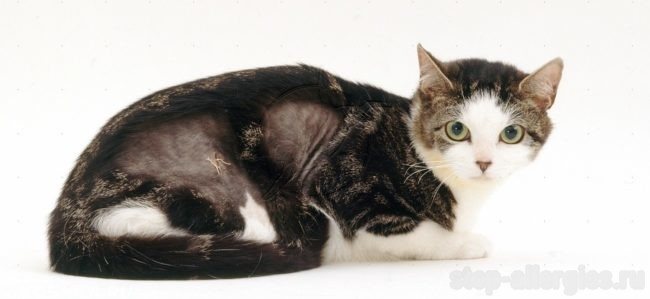
You can cure eczema in a cat at home using the following recipes:
- Decoction of willow bark. The product is easy to prepare: 2 tbsp. l. bark use a glass of water, place the container on the stove and bring to a boil. Then reduce the heat and cook for another 10 minutes. The cooled and strained broth is used to wash the animal's wounds several times a day.
- Tincture of burdock and dandelion roots. To prepare the tincture, you can use both fresh and dried ingredients. The ingredients taken in equal proportions are mixed (2 tablespoons each), and 0.5 liters of vodka are poured. The product is left to prepare for 10 days in a dark place. The resulting solution is used to lubricate erosions, reducing the severity of itching and other symptoms, in the morning and evening for a week.
- Celandine ointment. An effective remedy is prepared from a fresh plant and can be stored in the refrigerator for a year. The preparation is prepared at the rate of 1 part celandine to 4 parts petroleum jelly. The pulp from the plant along with its juice is thoroughly mixed and combined with Vaseline. After which the resulting composition is sent to the refrigerator and used to treat eczema in humans and animals, applying to the affected areas 2-3 times a day.
- Compress made of celery and sunflower oil. To prepare the medicine, you will need crushed plant root mixed with unrefined oil. The herbal composition helps relieve swelling and itching; it can be applied to dry eczema, as well as at the stage of blistering.
- Infusion of currant leaves. Use a handful of fresh or dry leaves for 2 cups of boiling water, leave to steam for an hour, and, after straining, use to wash wounds.
Eczema wounds are washed with infusion of currant leaves.
A predisposition to the development of dermatosis does not mean that an animal will definitely develop it. Treatment of eczema in cats is not necessary at all if the owners take the required preventive measures to prevent skin diseases. In addition to the rules of careful hygiene, it is necessary to adjust the pet’s diet, preventing the presence of harmful allergenic products in it.
How is it treated?
At the first appearance of symptoms of this disease, you should immediately take your cat to the veterinarian. The main condition for the pet’s recovery is good care: the cat must be placed in a warm room with no drafts. The hair from the affected areas must be shaved and then treated with alcohol.
The veterinarian prescribes topical medications; treatment of eczema in cats is required immediately, before test results are received. Apply moisturizing or astringent ointments to the wounds.
The animal's fur is trimmed. Foci of inflammation are treated with the help of an antiseptic, especially with weeping eczema.
Apply lotions, ointments and powders.
Effective treatment of weeping and dry eczema in cats necessarily includes supportive therapy: immunostimulants, sedatives, SSD antibiotics, stop-itch suspensions.
During the period of illness, the cat should eat fermented milk products, not experience stress and be kept in comfortable conditions.
Traditional methods of treating eczema in cats at home
Eczema in a cat:
- To normalize well-being, sedatives are used - bromine, chloral hydrate. This is an important component of treatment, as it breaks the vicious circle of itching - nervousness - further deterioration.
- Antiallergic treatment: calcium chloride and sodium thiosulfate, administered intravenously, also work to reduce allergies, which is an essential component for eczema. Accordingly, itching of the skin is also relieved.
- Antihistamines are also introduced - tavegil, suprastin. They are also aimed at relieving allergic manifestations.
- It is necessary to introduce multivitamins into the diet.
- The amount of meat in the diet is reduced, dairy and plant products are added.
- Diuretics (furosemide) are given orally to more quickly remove toxins from the body. It is important to ensure that the animal drinks enough water.
- The hair from the affected areas is carefully trimmed, after which local therapy is applied, which depends on the stage of the process:
- wetness is treated with a solution of rivanol or a 2% solution of silver nitrate;
- when the amount of discharge decreases, the following ointments are used: salicylic-zinc, xeroform, zinc;
- salicylic ointment, resorcinol, ointments with antibiotics and sulfonamides can be applied to pustules;
- if this treatment does not help well, you can apply ointments with hormones for a short time - hydrocortisone or prednisolone, fluorocort, lorindene.
The same treatment is used to treat eczema in dogs - it is only important to consult a veterinarian and change medications when the stage of the process changes.
Traditional medicine is also used to treat eczema in cats and dogs:
- weeping eczema is well treated with decoctions of oak bark and chamomile;
- When the weeping subsides, it is good to treat the wound surface with aloe juice and levomekol;
- Chronic eczema (dry) can be treated with sea buckthorn oil and vitamin A.
Appropriate treatment is prescribed by a veterinarian depending on the stage of development of eczema, the manifestation of symptoms and the condition of the animal itself.
Eczema in cats is treated with various sedatives. These include drugs chloral hydrate, bromine and caffeine.
At the discretion of the doctor, nonspecific therapy can be prescribed, the essence of which is to administer intravenously solutions of calcium chloride and sodium thiosulfate, and intramuscularly - sodium gluconate.
Eczema is treated with autohemotherapy. Diphenhydramine, suprastin and multivitamins are prescribed.
Glucocorticoid and novocaine therapies have proven themselves to be excellent in the fight against this disease.
If a cat has long-term, very persistent eczema, corticosteroids are used for treatment, which are applied in the form of an ointment with steroid hormones or orally.
Prescribe 0.5% prednisolone or 1% hydrocortisone. If eczema is a consequence of a disease of the internal organs, complex treatment is prescribed.
Treating eczema can only be done by a veterinarian. The earlier a specialist is involved, the greater the likelihood of avoiding complications. The veterinarian will order tests to determine the cause of the pathology and prescribe medications for external treatment.
The dry form of the disease is treated with moisturizing creams, hormonal ointments such as Lorinden, Sinaflan, Flucinar, which relieve inflammation and itching. Weeping eczema in dogs requires the use of antibiotics (Streptocide powder) and antiseptics (iodoform, Levomekol, Septogel), astringent ointments (containing zinc oxide), and powders.
The wet type is more difficult to treat than the dry type.
To carry out local treatment of the lesion, the animal's hair is cut and disinfected with an antiseptic (alcohol, hydrogen peroxide).
Drug treatment also involves the use of drugs orally: these are antibiotics, sedatives, vitamin and mineral supplements in tablets and liquid form, immunomodulators, antihistamines (Stop Itching suspension).
As soon as you notice the first symptoms of eczema in your cat, be sure to contact your veterinarian without treating the affected area with anything, as this may complicate further diagnosis.
The doctor will prescribe the necessary medications for local treatment, cut the hair and apply an antiseptic. To treat eczema in cats, local hormonal agents in the form of lotions, ointments and powders are also used.
It is important to note that for successful treatment of eczema in cats, you should follow the necessary diet and include fermented milk products in the animal’s diet. Try to limit the cat from stress, surround it with care and be sure to include supportive therapy in the treatment in the form of sedatives, immunostimulants, anti-itching suspension, etc.
The doctor will prescribe the necessary medications for local treatment, cut the hair and apply an antiseptic. To treat eczema in cats, local hormonal agents in the form of lotions, ointments and powders are also used.
READ MORE: Will Bepanthen help with eczema on the hands
It is important to note that for successful treatment of eczema in cats, you should follow the necessary diet and include fermented milk products in the animal’s diet. Try to limit the cat from stress, surround it with care and be sure to include supportive therapy in the treatment in the form of sedatives, immunostimulants, anti-itching suspension, etc.
The dry form of the disease is treated with moisturizing creams, hormonal ointments such as Lorinden, Sinaflan, Flucinar, which relieve inflammation and itching. Weeping eczema in dogs requires the use of antibiotics (Streptocide powder) and antiseptics (iodoform, Levomekol, Septogel), astringent ointments (containing zinc oxide), and powders.
The wet type is more difficult to treat than the dry type.
Only a well-trained veterinarian can tell you how to treat millet dermatitis at home. In no case should you do this on your own, since without correct diagnosis it is impossible to “by eye” calculate the main cause of the disease.
Without this, any attempts to get rid of the external manifestation of the disease, which is miliary papulocrustous feline dermatitis, can be hopeless. At best, a temporary improvement in the animal’s condition can be achieved, but without curing the underlying problem, the cat’s eczema will enter a protracted chronic stage.
In all cases, the doctor selects an ointment for eczema individually, depending on what caused it. To get rid of the underlying disease, traditional specialized treatment is used: for bacterial infections, antibiotics are given, neuroses are treated with sedatives, the animal’s hormonal problems are solved, allergies are relieved, fleas are destroyed, worms are expelled, and so on.
Cleanliness is extremely important. You need to wash the animal with special shampoos prescribed by a veterinarian; they quickly relieve itching and alleviate the condition of a sick cat.
It is also necessary to completely disinfect the premises, throw out cat litter and treat for eggs of fleas and other insects, remove possible allergens from the house, and take care of changing the animal’s diet.
As for traditional methods of treatment, they suggest the use of tar soap, bathing in a decoction of the string, a calm environment for the animal and proper nutrition with a large amount of biotin in the food.
All these methods make it possible to alleviate the suffering of a sick animal and restore its beautiful appearance, health and cheerfulness.
The veterinarian prescribes topical medications; treatment of eczema in cats is required immediately, before test results are received. Apply moisturizing or astringent ointments to the wounds.
The animal's fur is trimmed. Foci of inflammation are treated with the help of an antiseptic, especially with weeping eczema.
Apply lotions, ointments and powders.
Post Views: 52
The veterinarian prescribes topical medications; treatment of eczema in cats is required immediately, before test results are received. Apply moisturizing or astringent ointments to the wounds. The animal's fur is trimmed. Foci of inflammation are treated with the help of an antiseptic, especially with weeping eczema. Apply lotions, ointments and powders.
Effective treatment of weeping and dry eczema in cats necessarily includes supportive therapy: immunostimulants, sedatives, SSD antibiotics, stop-itch suspensions.
During the period of illness, the cat should eat fermented milk products, not experience stress and be kept in comfortable conditions.







